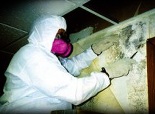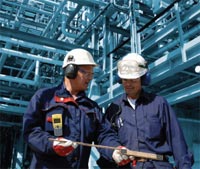
As of Oct. 1, every person who works on a residential mold remediation project in the state of Maryland will be required to hold an individual certification from the council, an independent certifying body based in Glendale, Ariz.
The agency implemented the change on Tuesday, issuing a program policy letter telling mine enforcement personnel how to sample for DPM.

The highly popular NIOSH director has championed important work such as nanotechnology research, which is turning up new concerns about carbon tubes.
The two-part event, led by hearing conservation expert Elliott Berger, will discuss hearing protection performance ratings, overall effectiveness of hearing protection, the potential impact of changing NRR standards on the horizon, and communications in noise.
Initially, the biosensor will be configured to detect the presence of common and rare strains of microorganisms associated with water-borne illnesses and fatalities, officials said.
"The citations address a variety of hazards which, left uncorrected, expose employees to chemical burns, fire, electrocution, lacerations, amputation, falls and crushing injuries, and impede their ability to exit the workplace swiftly in the event of a fire or other emergency," said Christopher Adams, OSHA's area director in Syracuse, N.Y.
The new standard, OR-OSHA Administrative Order 6-2008 for general industry and construction, will be effective July 1.

This photo show's the historic Third Avenue Bridge in downtown Minneapolis, where AIHce 2008 will open its doors May 31.
Evidence concerning the health risks of coarse particulate matter of greater than 2.5 micrometers and 10 micrometers or less in aerodynamic diameter is limited, and findings have been mixed, researchers say.
A recent study extolling the virtues of physical activity toward lowering women's risk of breast cancer before menopause should provide plenty of incentive to take part in this year in AIHce's 24th Annual American Industrial Hygiene Foundation's Fun Run/Walk.
If there are any industrial hygienists out there that are feeling a little bit unappreciated, don't despair. It's time once again for the annual American Industrial Hygiene Conference and Expo (May 31-June 5). Hosted this year in the great city of Minneapolis, thousands of professionals are expected to flock to the Minneapolis Convention Center.
Does exposure to nanoparticles pose a health threat to workers? Pending further research to clarify the risks, nanotechnology companies need to consider what steps they will take to protect the health of employees exposed to engineered nanoparticles, according to a study in the May Journal of Occupational and Environmental Medicine, official publication of the American College of Occupational and Environmental Medicine (ACOEM).
Three employees were killed by steam and hot ash when boiler tubes ruptured in the lower vestibule/dead air space of boiler Unit #3 in the plant's boiler house in Salem, Mass.
"Employees and management at the Wallingford facility take a proactive approach to safety and health, so they can identify and remove work-related hazards before they harm employees," said Marthe Kent, OSHA's regional administrator for New England.
"Facilities that process particularly toxic chemicals, such as lead, must follow reporting rules to ensure area residents and emergency response personnel are informed of possible chemical hazards locally," said Nathan Lau, Communities and Ecosystems Division Associate Director for EPA's Pacific Southwest region.
The company was also cited for failing to implement a mechanical integrity program for pressure relief devices and fixed equipment, and failing to correct deficiencies associated with vessel and piping wall thicknesses.
The Wisconsin-based manufacturer of monitoring equipment, especially for noise monitoring, enhances 3M's presence in the IH and safety markets, the company said.
On Jan. 16, 2002, two workers were killed and eight others were injured when they inhaled hydrogen sulfide gas leaked from an underground process sewer at the Georgia-Pacific Naheola mill in Pennington, Ala. Among the injured were workers who attempted to assist their colleagues from the deadly cloud. The gas was the product of a sudden, uncontrolled chemical reaction taking place in the sewer as the men worked above.

The writing of this article follows on the heels of a meeting between the author and the chief deputy attorney general of the Commonwealth of Pennsylvania. The purpose of that meeting was to investigate and discuss the circumstances of a fatal Pennsylvania mining accident.